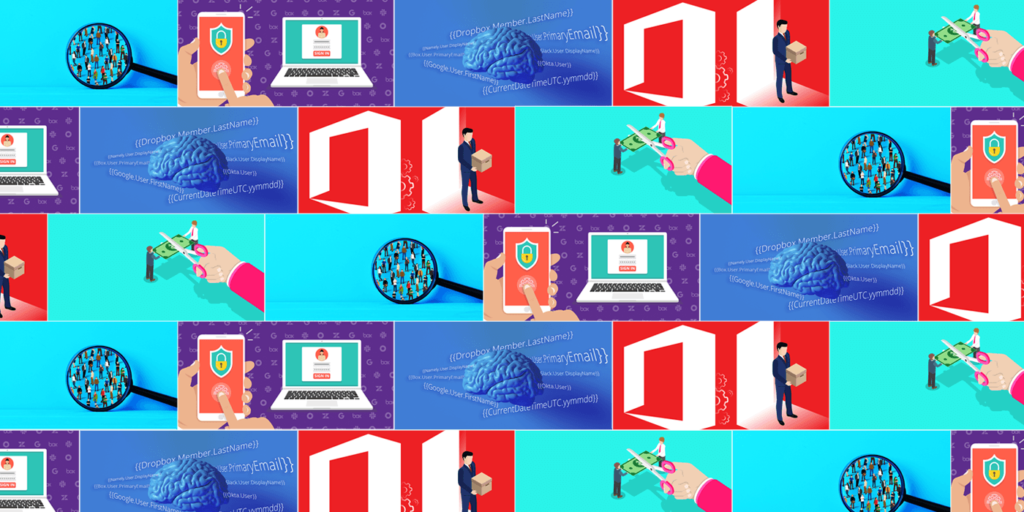The comprehensive guide to SaaS spend optimization
June 9, 2025
13 minute read

Today’s organizations run on SaaS – and coffee, although coffee is probably a close second. But let’s get back to discussing SaaS spending. In this comprehensive guide to SaaS spend optimization, we’ll walk you through the essential strategies for cutting SaaS spending, optimizing SaaS costs, and gaining SaaS budget control.
Right-sizing your SaaS spending: How did we get here?
Sure, SaaS tools offer flexibility and scalability for every department in your organization, but this convenience has come at a cost (both literally and figuratively). For too many organizations, SaaS subscriptions have grown faster than understanding of them and the annual BetterCloud reports on SaaS tell the story.
As we see in the chart below, after years of fast growth, the pace of SaaS adoption began to moderate in 2021, and then peak at an average of 130 SaaS apps per organization in 2022. The following year, in 2023, the average number of apps contracted for the first time ever down to 112.
And then for the second year in a row, in 2024, the average number of SaaS apps continued its decline from the prior year. That average number of SaaS apps per organization now stands at 106 different tools,
In sum, rapid growth finally gave way to rationality.
Changing enterprise SaaS spending
Again, according to BetterCloud’s most recent report, The 2025 BetterCloud State of SaaS Report, 21% or organization cut SaaS spending in the last year, while 33% consolidated apps or accounts.
And the reasons for SaaS budget spending cuts and consolidation are probably familiar to you and your IT team.
- About 42% of organizations tell us the IT budget pressures drive spend optimization
- Another 21% say they have too many unused and/or underutilized SaaS apps and licenses
- Finally, 13% tell us big SaaS price increases drive the needs to consolidate the SaaS stack.
But first, let’s back up and explain where SaaS spend optimization fits in with spend management.
SaaS spend optimization is part of SaaS spend management
While these two terms are related, they are not the same.
Let’s first start with spend management. SaaS spend management is the active management of your organization’s SaaS spending and budgeting for the applications that run your organization.
Done properly, it essentially involves a broad set of activities like:
- SaaS cost policy creation and management
- SaaS discovery of apps that authenticate to your domain
- Usage monitoring
- Cost analysis by user, department, and application
- License allocation by user and department
- Contract negotiation
- SaaS vendor management
- License optimization according to usage, entitlements, and employee sentiment.
Meanwhile, SaaS spend optimization is a SaaS spend management process where the primary goal is to right-size your organization’s SaaS costs and contracts. The aim is to avoid unused and underutilized licenses across the organization’s entire spectrum of SaaS apps.
Why SaaS spend optimization strategies matter now more than ever
The era of unchecked SaaS adoption has come to an end. Several factors are converging to make SaaS spend optimization strategies a critical priority.
Tops among them are those loose SaaS procurement policies that have led to a mysterious, needlessly cluttered, bloated SaaS stack and all the problems that roll downhill from it.
For example, this comes along with unnecessarily inflated SaaS invoices, too many vendors, and an IT management nightmare – one that spreadsheets and manual monitoring can’t easily subdue.
9 Common SaaS spend management struggles
Each organization is different, and how best to handle your spend management challenges depend on how much you experience the typical ones. Do any of the following sound familiar to you?
- Difficulty keeping track of SaaS contracts. Each SaaS vendor contract comes with its own terms, renewal periods, and dates to track. Some may require a 60-day notice to cancel, while others auto-renew with current (and probably overpriced) pricing and terms.Now multiply this already time-consuming activity by the number of apps your company uses, and it’s easy to see why spreadsheets don’t cut it, leading to inadvertent auto-renewals or missed renewals that lead to operational disruptions.
- SaaS spending blindspots. To understand how much an employee and department uses each SaaS app by license tier, IT must login to each native console, view logs, and then make sense of it all by allocating costs according to accrual accounting standards.
- Too many redundant accounts or apps solving the same use case. Up until recently, most companies’ policies allowed departments or employees to buy an app without involving IT. Organizations then found themselves with many different accounts of the same app, or many apps with a similar use case, driving up costs and management overhead, and robbing them of enterprise pricing tiers and better deals.
- No standard, collaborative SaaS purchase and renewal processes. Without top management mandating policies that require finance and IT involvement, there’s no discipline and due diligence in buying and renewing. All too often, you don’t get the best apps, prices and terms.
- Too time-consuming for IT to manage SaaS users, spend, licenses, security, and compliance, as well as the automations prevent waste. SaaS spend management problems are inextricably related to IT’s larger SaaS management challenges. Without automating SaaS tasks, there’s no time to properly manage the stack and corresponding SaaS spend.
- No automated way to standardize on sanctioned SaaS apps. Reining in multiple accounts and use cases into a single, organization-wide standard isn’t trivial. IT must have multiple meetings with all stakeholders, devise important criteria for the standard, and then move employees to new organization-wide standard SaaS apps – all while hoping employees embrace the new app. It’s a long and messy undertaking, so too many IT teams live with and support more apps than they should.
- Unwieldy file governance. File sharing permissions are nearly impossible to manually monitor, but one file wrongly shared can have dire financial consequences on SaaS spending and the whole company.
- Burdensome compliance to spending and security policies. Proving compliance takes time. Even if there are SaaS spend optimization policies, IT needs to take the time to do periodic discovery, login into native consoles to view invoices, contracts terms, and their current compliance certifications. And, of course, it takes time to reconcile them with finance and legal. The task isn’t done nearly to the degree of precision and frequency that it should be, exposing compliance gaps.
- Lack of employee awareness and training. Employees need to be aware of the company’s SaaS purchasing policies and the importance of responsible software buying and usage. Training programs can help educate employees on the Shadow IT risks, financial risks, and the benefits of using approved SaaS applications.
To top it all off, facing these challenges is on-going requiring active management. This is exactly what SaaS spend management processes and spend optimization strategies are meant to tackle.
SaaS spend optimization takes time
Consolidation that the BetterCloud reports showed started a few years ago, will likely continue for a few more. And there’s some good reasons why.
Among the biggest barriers to instant SaaS costs cuts or optimized SaaS spending are contractual obligations. Thanks to SaaS vendors’ terms and conditions, contracts generally prevent organizations from simply stopping payment for SaaS apps and licenses they don’t use.
Then consider that some of those apps have multiple year contracts, so it takes time to wind them down.
And then there’s a second reason: for some apps, consolidating is risky business. Such apps tend to be more complex, bringing high business operational risk in the event of a disruption.
Good examples are cloud contact centers or customer experience platforms.
These types of apps usually require lengthy data migration or integration periods. Switching or consolidating these kinds of apps, even when they’re the same app and same vendor with multiple accounts can be tricky.
Finally, strategically curating the enterprise tech stack to drive efficiency, security, value, and tangible business results requires processes that stretch beyond SaaS spend optimization strategies into managing the entire SaaS lifecycle.
Be patient in your SaaS spend optimization pursuits. Moving from one app to another can be long and difficult. Or in other cases, app contracts need to expire. When you consider the other demands of SaaS management, consolidating and cutting SaaS spending is likely to continue for you and many organizations for the near future.
The foundation of any SaaS spend optimization strategy: visibility and data
Imagine trying to manage your household budget without knowing all your income sources and expenses. The same principle applies to SaaS. Without a comprehensive view of all your subscriptions, you’re flying blind.
Decentralized SaaS management, where individual teams procure their own tools, often leads to duplication, underutilization, and missed opportunities for cost savings. A centralized inventory acts as a single source of truth, providing the necessary foundation for effective optimization.
Methods for discovering your SaaS subscriptions
Building this inventory requires a multi-pronged approach.
- Manual audits and stakeholder interviews: Start by engaging with department heads and key personnel to understand the tools they are using and why. Spreadsheets can be a starting point, but they quickly become unwieldy.
- Leveraging finance and procurement data: Examine expense reports, credit card statements, and accounts payable records for recurring SaaS charges. Collaborate with your finance team to identify subscriptions that might have slipped under the radar.
- Utilizing SaaS management platforms (SMPs) and discovery tools: These specialized tools automate the discovery process by integrating with your financial systems, email platforms, and network activity to identify all connected SaaS applications. They offer a far more efficient and comprehensive approach than manual methods.
Key data points to track for each subscription
Once you begin identifying your SaaS tools for cutting SaaS spending, it’s crucial to gather relevant data for each one:
- Usage metrics (active users, feature utilization): Understand how frequently and deeply each tool is being used. Are you paying for licenses that aren’t being actively utilized? Are teams only using a fraction of the available features?
- Contract terms (renewal dates, pricing models, commitment levels): Be acutely aware of when contracts are up for renewal to avoid costly auto-renewals. Understand the intricacies of your pricing model (per-user, tiered, usage-based) and any committed spending levels.
- Ownership and department responsible: Knowing who owns and uses each tool is essential for accountability and communication regarding optimization efforts.
- Integration with other tools: Understanding how different SaaS applications connect can reveal opportunities for consolidation or identify critical integrations that need to be maintained.
Effective SaaS spend optimization strategies
With a strong foundation rooted in an understanding of your entire tech stack, you can start finding opportunities for optimizing SaaS costs and cutting SaaS spending.
Analyze usage patterns to identify savings opportunities
Although a spreadsheet will do for a few apps or users, it’s a harder task to complete as your SaaS footprint scales. However, it’s easy to do with a SaaS management platform. Such tools usually provide detailed usage analytics for all your apps. You can easily identify the SaaS apps that have long sat dormant., Obviously, terminating them as soon as possible is the easiest way to cut SaaS spend.
In addition, an all-in-one SaaS management platform with spend management functionality can highlight users who rarely or never login. Reclaiming these unused licenses and redeploying them is the fastest path to optimizing your SaaS spend.
The grey area comes when determining what level of activity is deemed appropriate for users.
Remember that the definition of an “active” user varies from organization to organization and depending on the application.
For example, your marketing team may only put on one webinar a quarter, but they need access to a Zoom Webinars license to operate them. So even though the activity level may appear to be low, this license is still needed.
Considerations like this are necessary as you continue evaluating each SaaS app to cut SaaS spending to land at optimized SaaS costs.
Monitor both license usage and overall app usage
Your organization must regularly monitor software usage to ensure license optimization.
Beyond individual license management, consider the broader portfolio for opportunities to consolidate and negotiate.
Are there multiple applications performing similar tasks?
Can you achieve better pricing by bundling services with a single vendor?
Many SaaS providers offer volume discounts or enterprise agreements that can significantly reduce per-unit costs. Don’t shy away from negotiating terms, even for existing contracts. If your usage has increased, or if you can commit to a longer contract term, there’s often room for a more favorable deal. This also applies to upcoming renewals; proactive engagement with vendors well in advance of the renewal date gives you leverage and time to explore alternatives if negotiations don’t yield satisfactory results.
Implement a SaaS spending governance framework
In addition, it’s important to establish a continuous monitoring and SaaS governance framework. SaaS spend optimization isn’t a one-time project; it’s an ongoing discipline of monitoring and adapting. Implement clear policies for strong software procurement, requiring justification for new subscriptions and regular reviews of existing ones. Encourage collaboration and communication among stakeholders.
Assign ownership for managing SaaS licenses within departments, empowering them to monitor their own usage and identify inefficiencies.
Finally, to cut SaaS costs and spending, leverage specialized SaaS management platforms that can automate many of these tasks, as well as provide real-time visibility into spending, usage, and compliance.
By integrating these SaaS spend optimization strategies into your operational rhythm, you can ensure that your SaaS investments are always aligned with your strategic objectives, fostering a culture of efficiency and maximizing the return on every software dollar.
Measure the success of your SaaS spend optimization strategies
Key metrics to track. Define key performance indicators (KPIs) to measure the success of your optimization initiatives. These might include:
- Total percentage reduction in SaaS spend.
- Cost per active user for key applications.
- Number of reclaimed licenses.
- Return on investment (ROI) of your optimization efforts (e.g., the cost savings achieved compared to the investment in optimization tools and personnel).
Reporting and communicating results to stakeholders. Create clear and concise reports that highlight the impact of your optimization efforts. Communicate these results to leadership and relevant stakeholders to demonstrate the value of the program and secure ongoing support.
How BetterCloud helps with SaaS spend optimization
BetterCloud is a great swiss-army knife of a tool that offers incredible features and capabilities to help optimize your organization’s SaaS spend effectively. Here’s how BetterCloud delivers real value for IT and finance leaders.
Complete software spend visibility
Like we said earlier, visibility is the foundation for effective SaaS spend optimization strategies that cut SaaS costs and optimize budgets.
BetterCloud helps you achieve a “single pane of glass” into your entire tech stack – even the applications you don’t know about.
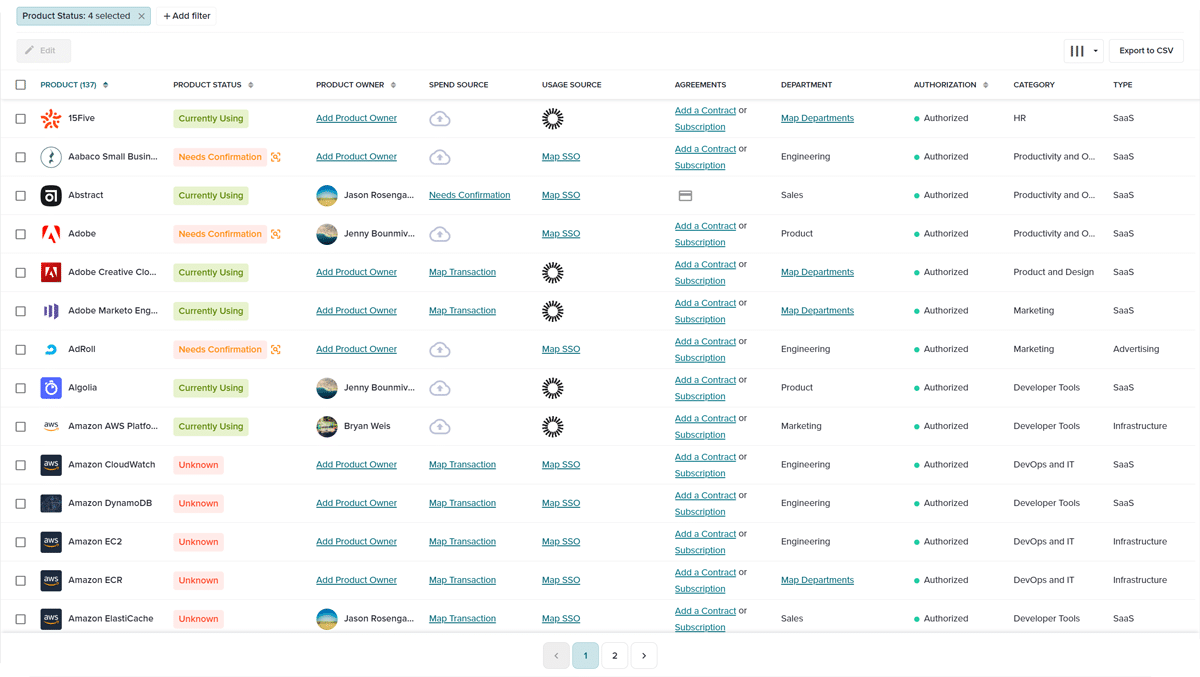
BetterCloud’s spend optimization module integrates directly with your accounting system as well as your SSO to pair usage data with transactions of existing and new software in your organization’s ecosystem.
Let’s say someone in HR—like Wendy—goes rogue and buys a new Adobe license without informing IT. With BetterCloud, that purchase doesn’t slip through the cracks. You’ll receive an alert about the transaction and be able to identify the unsanctioned software before it creates compliance risks or unnecessary costs.
This level of insight helps teams uncover shadow IT, reduce duplicative spend, and make proactive decisions about license usage, renewals, and consolidation. By using BetterCloud for SaaS spend optimization strategies, what was once invisible becomes fully actionable.
Tracking software usage and costs
Keeping track of your software usage and costs in a spreadsheet can be downright miserable. This manual effort is not only annoying, but quickly becomes out of date given the constant changes related to usage and varying costs.
With BetterCloud for implementing your SaaS spend optimization strategy, organizations can access usage insights on the department or even employee level by clicking directly into the product in the “All Products” tab. This level of granularity allows IT and finance teams to quickly understand who is using a specific application, how often, and whether the value justifies the cost.
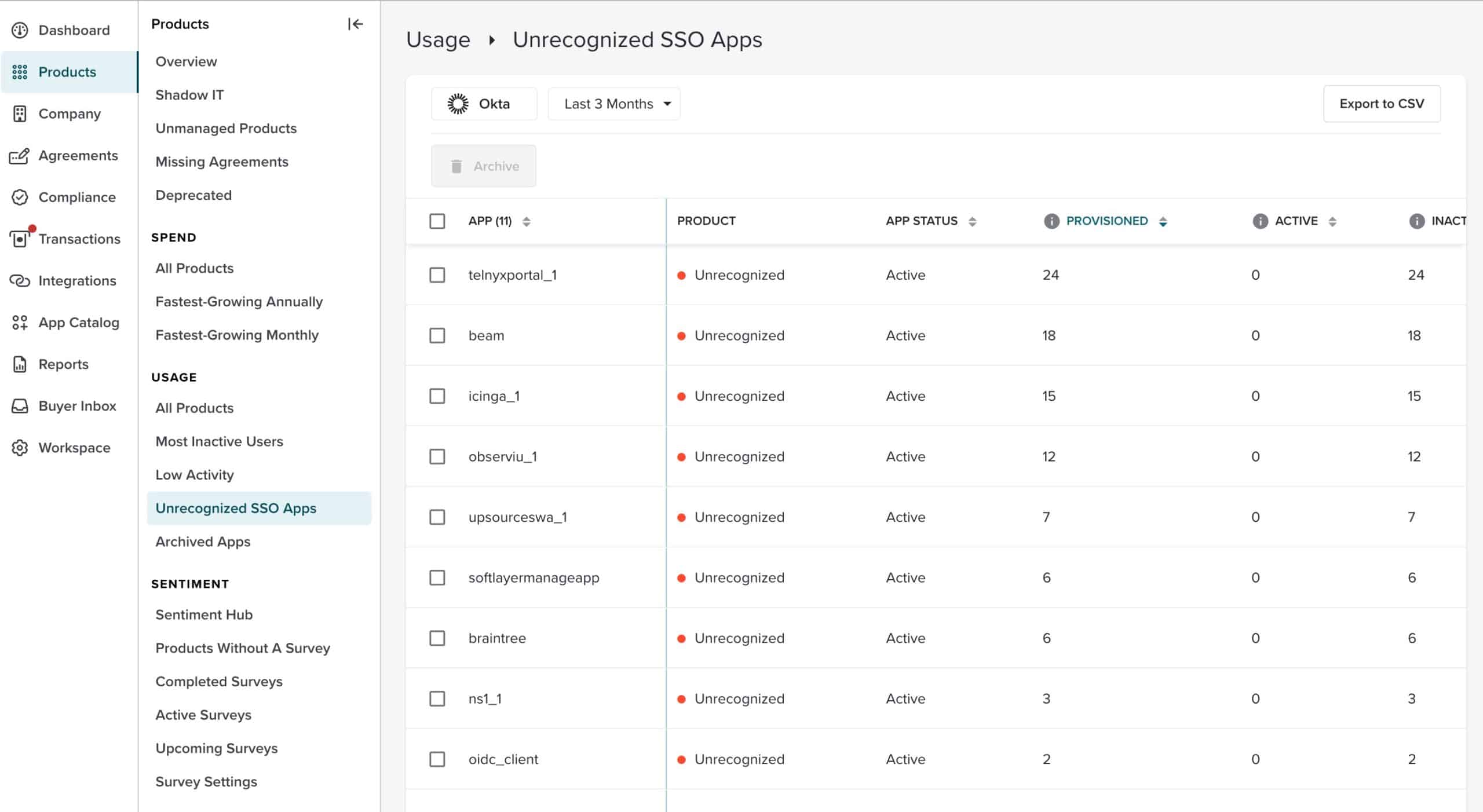
You can easily identify underutilized licenses, spot inactive users, and flag tools that are being paid for but rarely (or never) used. BetterCloud pairs these usage insights with spend data, giving you a clear view into cost per user or per department for each application. This makes it easier to track ROI, allocate budgets more accurately, and make informed decisions about renewals or reassignments.
Instead of reactive clean-up at the end of the quarter, BetterCloud enables ongoing, real-time software spend management—eliminating guesswork and putting actionable data at your fingertips.
Identify redundant subscriptions and other savings opportunities
The unfortunate result of not having the right amount of visibility is the lack of visibility into any overlapping software.
We’re not just talking about multiple instances of the same product, but when a new feature arrives in one platform that you didn’t know about that could save you serious money elsewhere.
With BetterCloud, organizations can easily deploy SaaS spend optimization strategies. They can identify not only redundant subscriptions, but overlapping products with similar functionality. This is done because BetterCloud has the largest taxonomy of all the SaaS spend management tools out there. This taxonomy removes the busy work of researching exactly what every application does and in turn powers the overlapping software insights that are readily available and updated as your tech stack evolves.
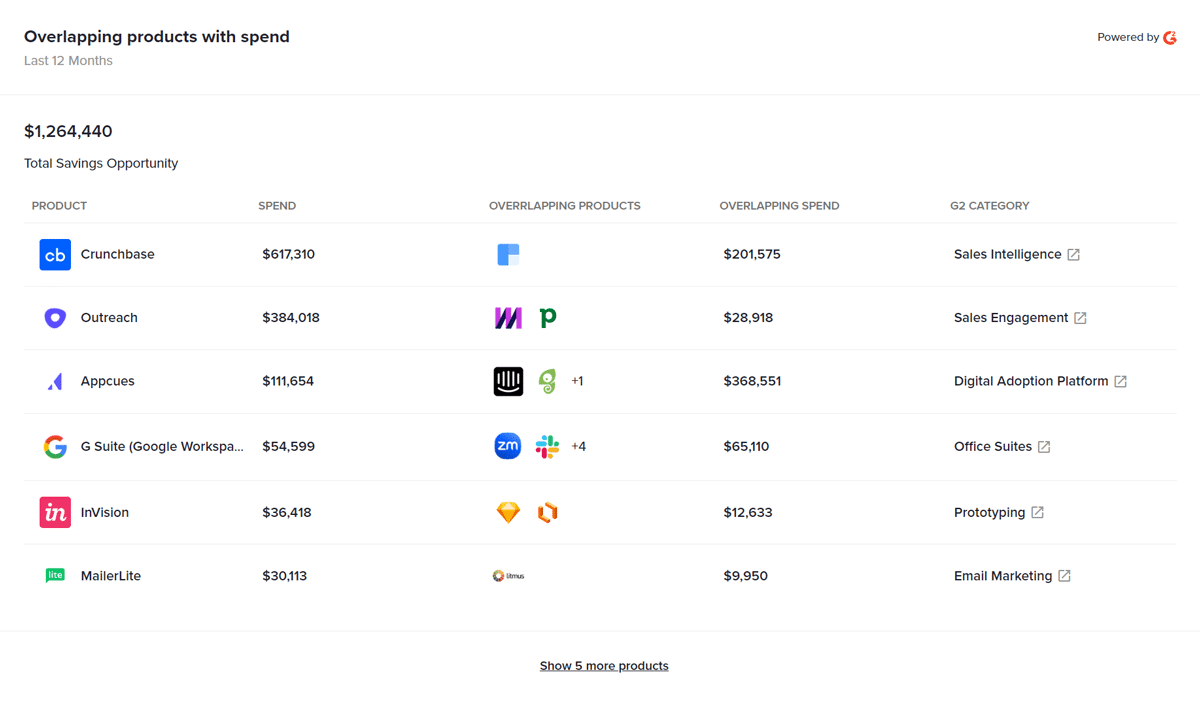
These transparent savings opportunities enable organizations to quickly save on software that isn’t needed.
Automated license management
That old spreadsheet of yours can’t keep up with your entire tech stack. As organizations scale and adopt more SaaS tools, manual tracking of licenses becomes not only inefficient—it becomes a liability.
BetterCloud’s SaaS spend optimization features take the burden off your IT and procurement teams by automating license management from end to end. Instead of chasing down who’s using what, BetterCloud continuously monitors license assignments, usage patterns, and access levels across your SaaS environment.
Need to reclaim a license from a former employee? For this kind of SaaS spend optimization, BetterCloud can automate that deprovisioning process the moment someone leaves. Want to reassign unused licenses to new team members or other departments? With BetterCloud, you can do that seamlessly—no spreadsheet updates or follow-up emails required.
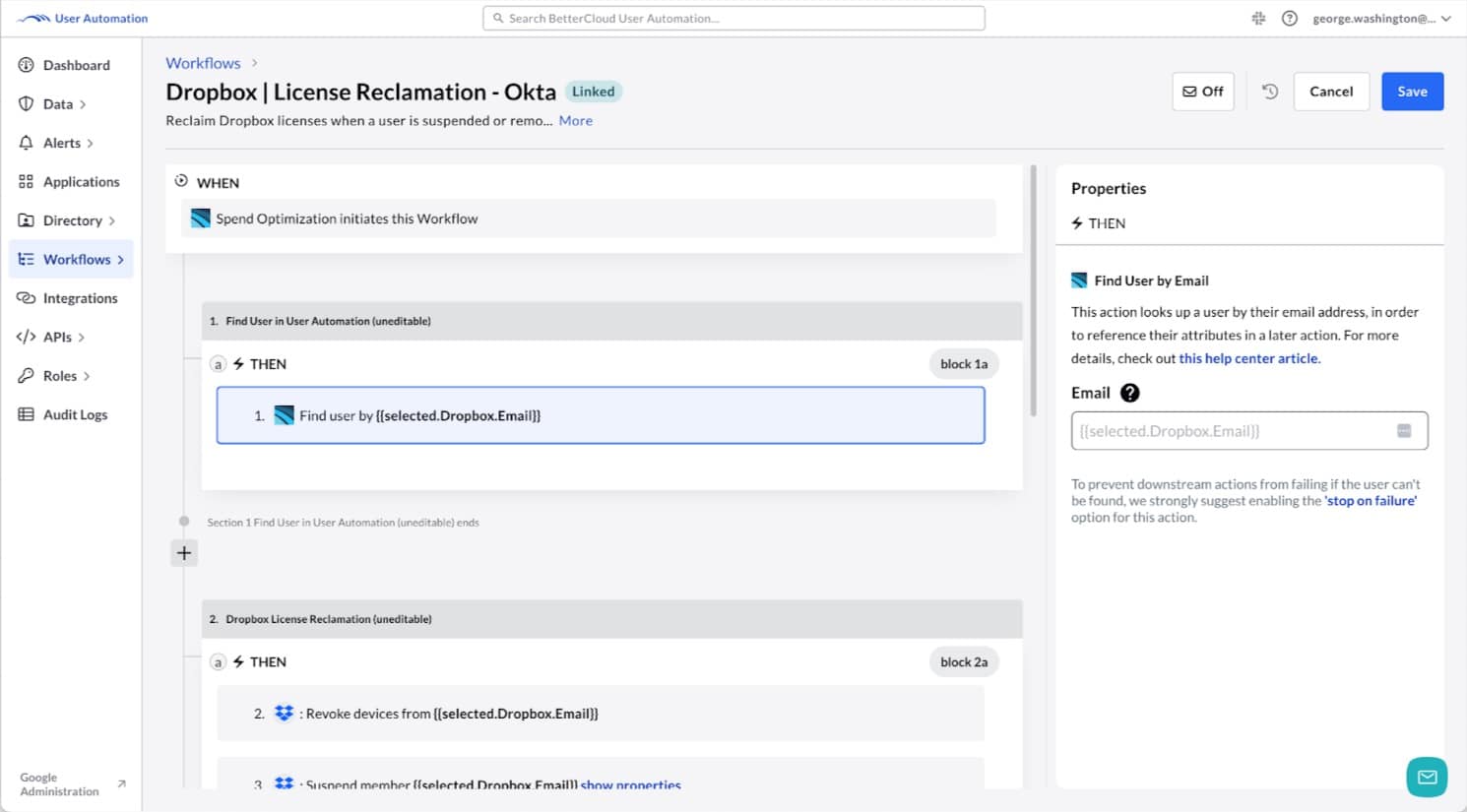
With dozens of applications natively supported with BetterCloud’s license reclamation action, revoking entitlements and licenses has never been easier – BetterCloud will directly revoke licenses within the SaaS app itself, ensuring a full and final reclamation that reduces SaaS costs and security risks.
Contract management paired with vendor negotiation insights
Software contracts often contain renewal clauses, tiered pricing structures, and usage commitments that can catch teams off guard if not closely monitored. SaaS spend management in BetterCloud simplifies this by centralizing contract data alongside usage and financial insights, helping you stay ahead of renewal dates and avoid surprise auto-renewals.
With access to real-time usage trends, BetterCloud SaaS spend optimization empowers your procurement or IT team with data-backed insights for vendor negotiations. For example, if actual usage is lower than contracted levels, you can renegotiate terms or shift to a more cost-effective plan. On the flip side, if usage is projected to increase, you can proactively discuss volume discounts or favorable enterprise agreements before costs spiral.
BetterCloud’s SaaS spend optimization capabilities also flag upcoming renewals, enabling your teams to take timely action. This prevents last-minute scrambles and opens the door to strategic vendor discussions that could result in better terms and long-term savings.
BetterCloud is the tool for spend optimization and SaaS cost control
When it comes to managing SaaS sprawl, cutting unnecessary SaaS costs,and optimizing SaaS spend, BetterCloud isn’t just another dashboard—it’s the control center IT has been waiting for.
IT leaders today are under pressure to do more with less. Between budget constraints and ever-growing stacks of cloud applications, staying ahead of wasted spend requires both visibility and actionability. That’s where BetterCloud comes in.
BetterCloud gives IT teams a clear line of sight into their entire SaaS ecosystem—who’s using what, how often, and whether it’s actually needed. With automated workflows and granular usage data, you can optimize SaaS spending by proactively provisioning unused licenses, rightsizing access levels, and even identifying shadow IT before it becomes a budget line item.
And this isn’t just theory—real customers are seeing real results. One customer uncovered over $100k in underutilized licenses immediately after onboarding BetterCloud. Another leverages BetterCloud for improving software contract negotiations and potential cost savings.
If your IT team is ready to shift from reactive cleanup to strategic SaaS spend optimization, BetterCloud makes it possible—not just to track SaaS costs, but to cut and control them.





